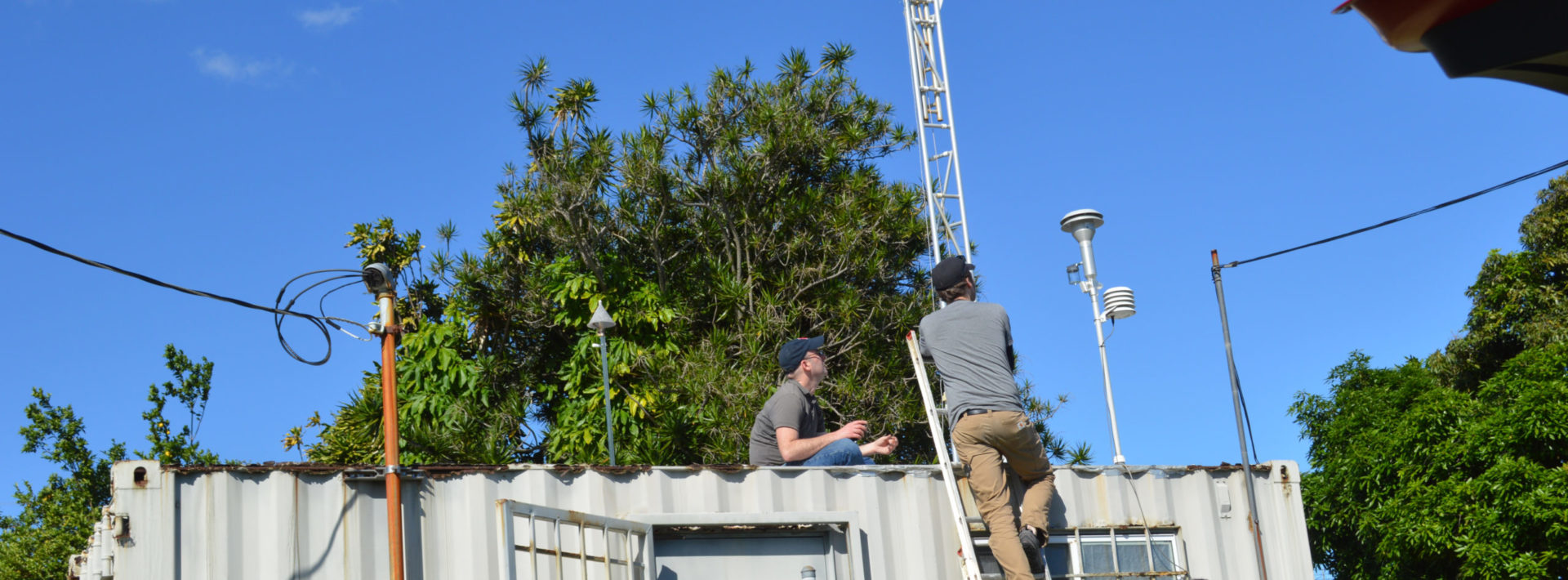TREX 2018 Day 2: When in Hawaii, Try Blogging for the First Time

By Josh Wilson ‘19
“Vog” is the dense smoke-like air volcanoes blasts out during an eruption. However, volcanoes also emit “vog” when they are active in lesser concentrations. Why is this important? The particulate matter in such emissions can cause serious health problems. As it stands already, Hawaii has an increased percentage of individuals suffering from asthma and other lung-related conditions. The cause of concern is found in SO2, or sulfur dioxide, the main chemical the peaks in Hawaii emit. TREX’s mission is to track SO2 concentrations and gain a better understanding of the risk Hawaiian citizens are potentially exposed to.
The short story is that breathing in sustained concentrations of greater than 75 ppb (parts per billion) creates a serious health risk. Moreover, the gaseous SO2 has the ability to react with evaporated water in the air, creating H2SO4 (sulfuric acid). When sulfuric acid inevitably mixes with the condensing water in clouds, you get acid rain. Since ecosystems are built around neutral water levels (pH roughly 7), acidic pHs can be very harmful to plant-life and not to mention structural metals used in homes, roads, shopping centers etc. The evidence was not hard to find as even stainless steel nails had oxidized and slightly rusted due to prolonged exposure. In past TREX trips, rain pH was measured at roughly 3.5! There’s a lot to study here in Hawaii, and we’re just getting started!
On our first day, I woke up at 7AM with the rest of the group to enjoy a breakfast of Honey Nut Cheerios (aka Old Reliable) and ever-important coffee. After a semester of anticipation, and the prior week of sensor-building and studying Hawaii’s topography and volcanic atmosphere, to wake up on the actual island felt rather surreal. My excitement was well reflected – I have never moved so quickly at 7AM to get ready for the day in all 21 years of my existence!
The agenda for the day included: stopping at Halemaʻumaʻu Crater to take in the sights, grocery shopping for the week, heading to Home Depot to purchase the materials we would need to mount our sensors and solar panels, and building a structure using said materials.

Hawaii graciously welcomed us with a light mist and scattered sunlight. The result was spectacular double rainbow, visible from one end to the other. While I made the ambitious goal to run out of storage space on my phone because I took too many pictures, as I reflect this evening, that goal may be more tangible than I previously imagined. The crater itself was massive; it appeared as though a giant meteor slammed into the earth denting it, and subsequently disappeared into thin air. The relatively high wind speeds captured the mist giving the crater a hazy, mysterious and majestic feel.

Next came shopping — not much to report here, besides the mandatory purchase of 4 pounds of poke. Raw Ahi tuna with different seasonings and spices associated with it. It’s amazing, I had it for lunch and I am eating it as I type. I highly recommend locating where poke is available near you.
Lastly, after buying some planks and adjustable brackets at Home Depot, we drove to a tiny Department of Health data outpost where we took-in the highly sophisticated equipment they use to also follow SO2 concentrations. I might add that this station was lower down the mountain, and the weather transitioned nicely from 60 and misting, to roughly 80 with nearly no cloud coverage.

The subsequent 3 hours were devoted to building a slightly inclined structure with our sensors mounted on either side. All the while we worked to meticulously check our sensors to confirm correct data logs and responses to particulate matter. While we all made the sensors together the week before on campus, each of us claimed two and naturally named them as if they were our very own new-born babies. I may be biased, but I have confidence that Calvin and Hobbes will collect the best data out of the group.

Calvin and Hobbes
The sensors themselves are battery powered, and, to ensure that it does not run out of power, they are hooked up to tiny portable solar panels (hence the incline in our structure, to optimize iridescence). We left right around sunset and drove to our temporary new home. I sit here satisfied, and exhausted, after a wonderful and complete first day in Hawaii. I look forward to some downtime and can’t wait to get back at it again tomorrow.
Every year, a group of MIT students and professors travel to the Big Island of Hawaii to gain fieldwork experience through TREX (Traveling Research Environmental EXperiences). The first TREX trip was held in 2000, and since launching has taken students on research activities in domestic and international settings. For more undergraduate opportunities, click here.



